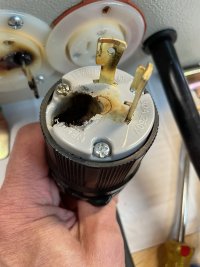schwartzr33
Well-Known Member
After 9 years of service, my homemade BIAB/HERMS control panel had a meltdown. The picture on the left is the plug that goes into the bottom of the control panel, which powers the heating elements (I move the other end of the cable between the mash/boil kettle and the HERMS). The picture on the right is the receptacle that the plug goes into. There are no other signs of anything burning in the control panel. This is a 240V, 30A system, built from Auber components. The two 5500W heating elements (one in the HERMS, one in the mash/boil) appear to be OK. I did not discover this until the brew day was complete.
Before I replace the melted plugs, can anyone offer any theories on what happened here? And how to prevent a recurrence? Thanks.
Before I replace the melted plugs, can anyone offer any theories on what happened here? And how to prevent a recurrence? Thanks.
Attachments
Last edited:





